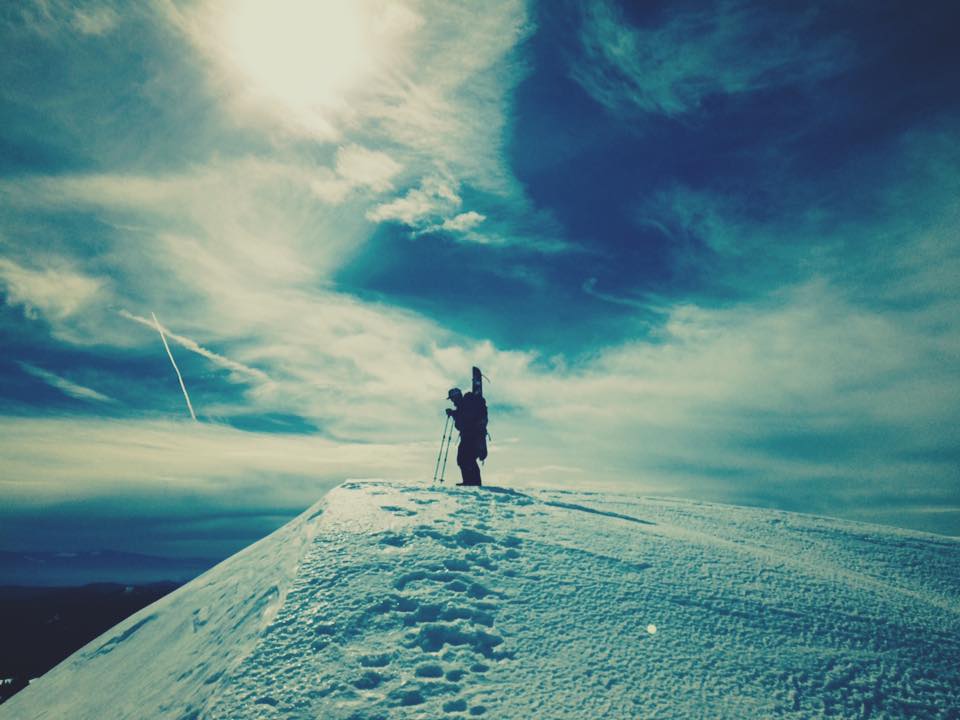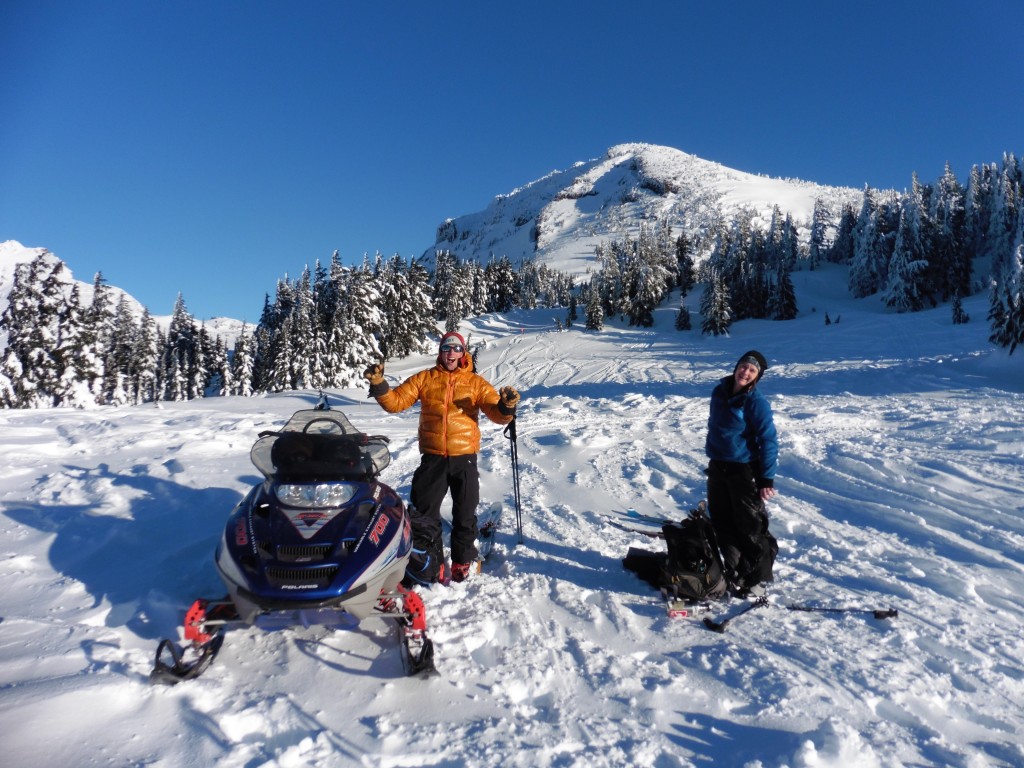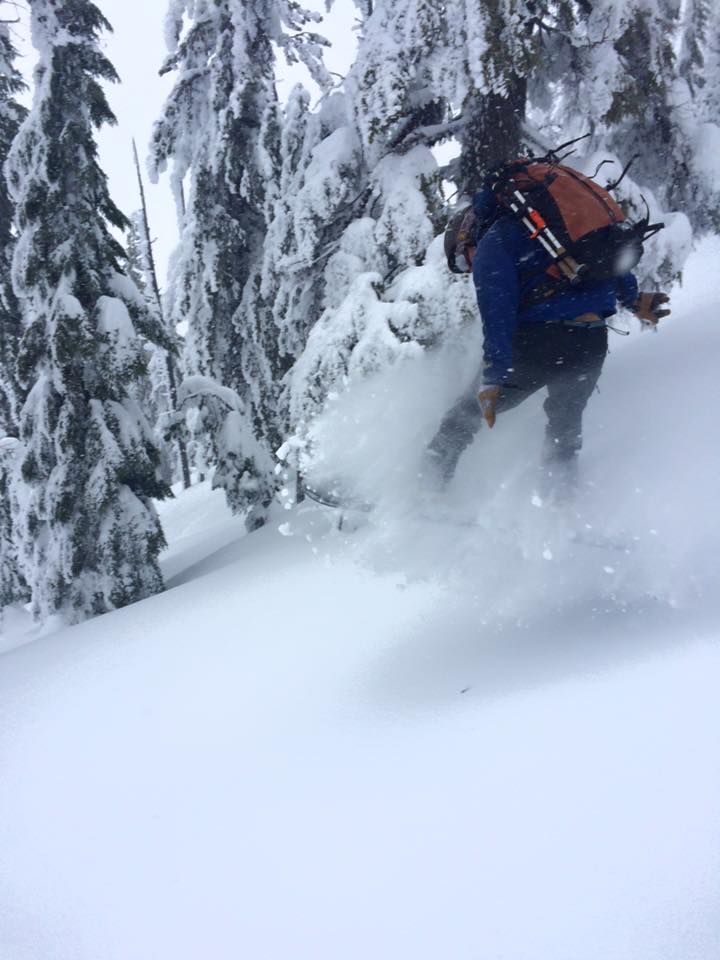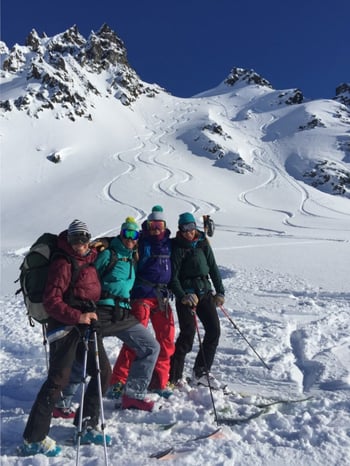Three winters ago I cut my old Never Summer snowboard in half and made a splitboard from the pieces. It was a fun project and the beginning of a new adventure exploring the winter backcountry around my home.

Taking in the view after bootpacking to the top of Ball Butte. Photo by Elliott Reed.
It's been a gradual progression for me transitioning from resort riding to backcountry touring, but a good one. After a couple years easing into the backcountry terrain around here, I decided this fall I was going to work hard to increase my skills. I’m not sure if it was something in the air, but this fall I felt pumped for winter and excited to explore.
As a side note, one thing important for you to know is that I love snowboarding. I started riding in 1995 at the New Hampshire ski hill Gunstock; Chris Palmer was my hero. Busy cutting my teeth on northeast boilerplate (icy ski conditions), I didn’t experience my first real powder skiing until I moved to Bend, Oregon in 2009. Having now become accustomed to Cascade powder dumps, my love of riding has only grown.
Goal-setting is something we always teach on NOLS courses, but something I don’t always do as effectively in my life at home. With snowboarding this winter I tried to set goals. My main goal was to get into the backcountry a lot and check out new terrain. To do this, I realized I needed to build my confidence and competence assessing and traveling through avalanche terrain; and I needed to find some good ski-partners—folks I trusted.
To get things going I signed up for the Winter Training Trip in December (thanks NOLS Teton Valley and NOLS training). We spent five days touring and winter camping around Fog Hill just south of Victor, Idaho. Highlights included learning to build quigloos, eating large amounts of processed meats, and, of course, incredible powder skiing, with over a foot on new snow on our course.
While not a formal avalanche course, our instructors Kate Koons, Kyle Drake, and Patrick Solomon were awesome and did a lot to teach us about backcountry travel and avalanche terrain. More than anything else, the seminar gave me some confidence and basic skills to come back to Oregon and explore my local terrain.
My drive home from Victor to Bend was through what felt like one massive snowstorm—even the Snake River Valley was coated in snow. The Cascades were getting absolutely pounded and so my snow-craze lived on with one central Oregon storm cycle bringing over five feet in the end of December.
I got out touring right away and making my own snow observations. Tumalo Mountain and Todd Ridge were were some zones I targeted early on, as they are accessible from the road and a lot of fun.
The next major advance in my winter exploration was teaming up with my friend and fellow NOLS instructor Elliott Reed. Elliott has a snow machine, a tool that massively expands the scope of accessibility here in central Oregon, a landscape characterized by generally flat terrain and big approaches to the mountains. Starting on New Year's Day 2016 and continuing into the following weeks, we used the sled to access a number of backcountry zones I had never been to before, including Broken Top, Ball Butte, Paulina Peak, and Tam Mcarthur Rim.
The snowboarding was awesome, but what I really enjoyed was exploring new places with my friends. It felt like an adventure.

Elliott Reed and Sarah Cuddy are pumped to be skiing powder on New Year's day 2016! Photo by Ethan Wolston.
All the while we were out there I worked hard to learn about the snowpack. In Bend we have no official avalanche forecast center, so we must rely on a variety of online resources, word of mouth, and our own observations to know what's going on.
At the end of January I got in touch with NOLS training and applied for an IDF grant to take an AIARE Level 1 course in Bend. By this time I had a little experience and some basic skills, but a very piecemeal understanding of broader avalanche concepts. I wanted to take a course to bring it all together and set me up for success in the future.
With the support of NOLS training, I took the Avy-1 class in early February. The course was put on by Oregon Ski Guides and provided an excellent foundation for broader understanding. I learned to better differentiate and define major avalanche problems and became more familiar with the lingo.
One of the most valuable parts of the course was practicing partner rescue and doing some digging exercises. It's hard to dig deep fast. I also learned a lot from doing a group search exercise—which further emphasized for me the importance of clear communication in rescue.
On the last day we got out and toured Ball Butte, where we braved low visibility and winds that were literally knocking folks over. The conditions were better than the rain the day before and challenged us to make decisions navigating avalanche terrain effectively in challenging conditions!
It was fun having some concrete goals this winter in terms of outdoor objectives. Having these goals helped motivate me to explore new backcountry zones and take advantage of some awesome training opportunities (thanks NOLS training). The winter odyssey fused my love of exploring new places with my passion for learning and made for a great time!
Now, the adventure continues.

Shredding powder on Paulina Peak in January. Photo by Elliott Reed.
- Adventure
- Educators Notebook
- Becoming An Instructor
- Education
- Backcountry
- Nols Teton Valley
- Backcountry Skiing
- Splitboarding
Written By
Ethan Wolston
Ethan lives in Bend, OR where he works part time for an arborist and loves getting outside to play. He has worked for NOLS for four years in the field and as a horsepacker and assistant manager at NOLS Three Peaks Ranch.




 The ladies. Photo by Kate Koons.
The ladies. Photo by Kate Koons.